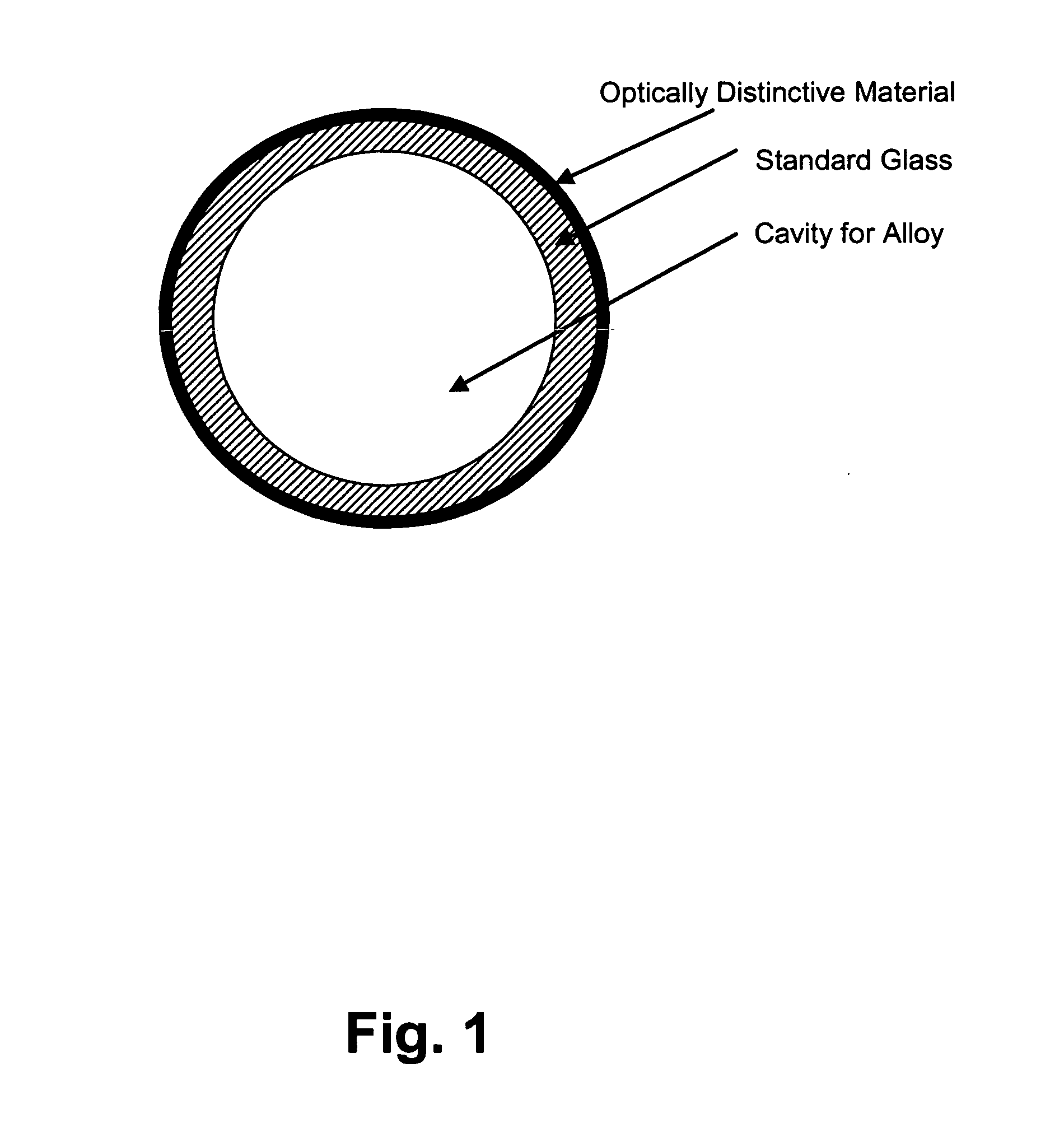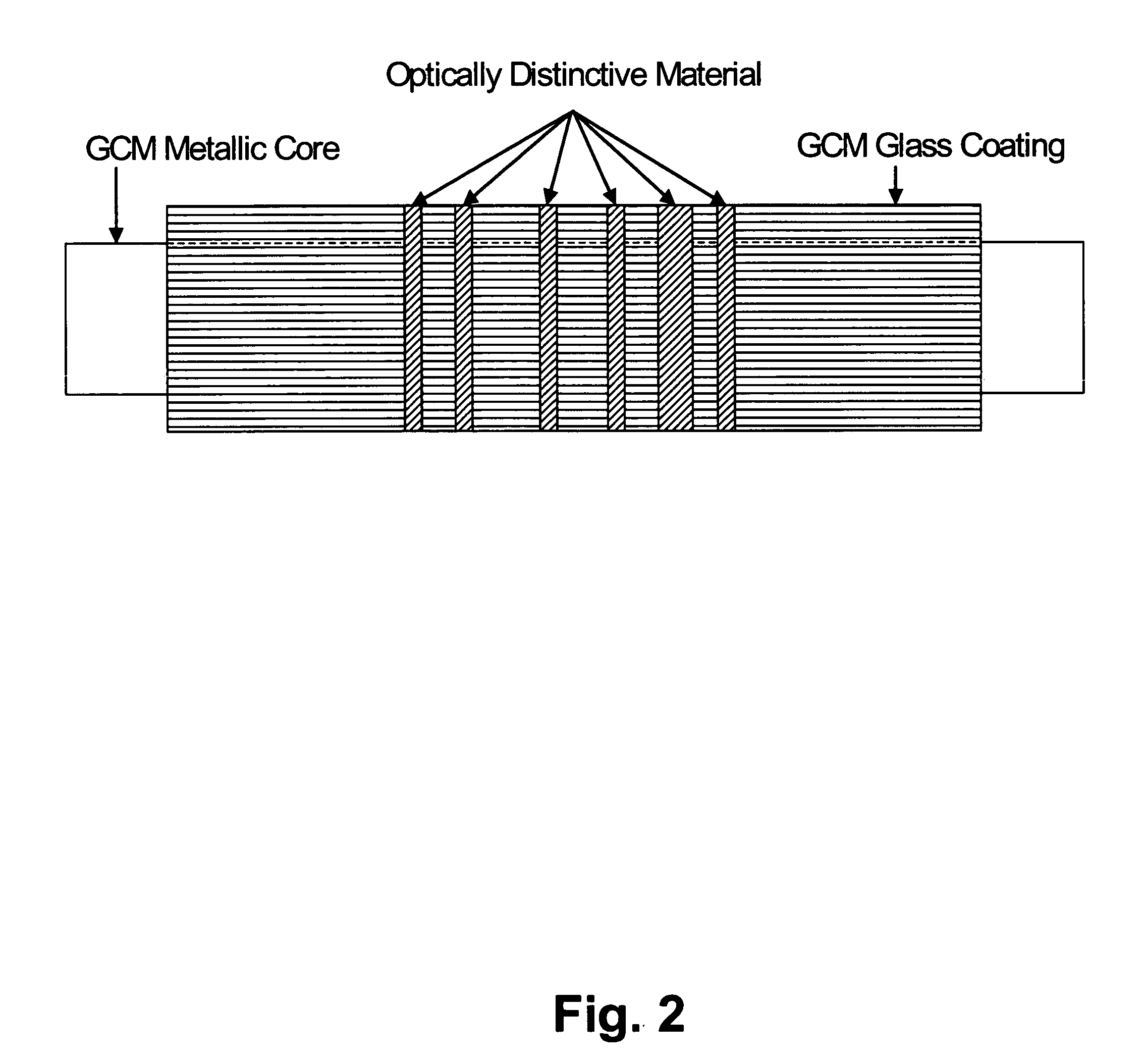Optically encoded glass-coated microwire
a micro-wire and optical encoder technology, applied in the direction of insulated conductors, cables, instruments, etc., can solve the problems of reducing the identifying characteristics, and the increase of the size, weight and cost of the marker
- Summary
- Abstract
- Description
- Claims
- Application Information
AI Technical Summary
Benefits of technology
Problems solved by technology
Method used
Image
Examples
example 1
[0057]An ingot composed of an amorphous-forming metallic alloy is prepared by loading the appropriate weights of constituent elements into a quartz tube that is sealed at one end. The other end of this quartz tube is connected to a pressure-vacuum system to allow evacuation and back-filling with Ar gas several times to ensure a low oxygen Ar atmosphere within the quartz tube. Next, the closed end of the quartz tube in which the elements reside is introduced into a high frequency induction-heating coil. With the application of radio frequency (“r.f.”) power, the elements inside the tube are caused to heat and melt into a stirred, homogeneous metallic alloy body. When the r.f. power is shut off, the alloy body is allowed to cool to room temperature in the Ar atmosphere. Once cooled, the same metallic alloy body is inserted into the bottom of a vertically disposed glass tube 1 (preform), having 6-mm diameter that is sealed at the lower end, as depicted in FIG. 5. The upper end of this ...
example 2
[0059]GCM for use in optical-based authentication is produced using the methods, materials and apparatuses of Example 1, except that the borosilicate composition used to form the glass coating of the GCM now contains a small amount of the rare earth element Europium (Eu). The incorporation of Eu into the glass composition results in the optical behavior shown in FIG. 6, wherein the detectable emission of light at 611 nm occurs when the glass is illuminated by broadband light having wavelengths between 420–600 nm. Note the dramatically increased output signal from the glass of this example, when compared to that of Example 1. Furthermore, the sensitive effect of Eu concentration on the resultant emission strength is shown thereby, providing a complementary means for providing authentication.
example 3
[0060]GCM for use in optical-based authentication is produced using the methods, materials and apparatuses of Example 1, except that the borosilicate composition used to form the glass coating on the GCM now contains a small portion of any one of the rare earth elements: Cerium (Ce), Praseodymium (Pr), Neodymium (Nd), Samarium (Sm), Europium (Eu), Gadolinium (Gd), Terbium (Tb), Dysprosium (Dy), Holmium (Ho), Erbium (Er), Thulium (Tm), Ytterbium (Yb), and Lutetium (Lu). Each individual rare earth element lends its own unique contribution to the host glass' intrinsic optical signature, which can then be exploited for authentication purposes. As for the Eu in Example 2, the unique optical signature due to the rare earth component is a function of the concentration. FIG. 7 shows optical emission spectra of an alkali borosilicate base glass of the same base glass doped with 1 mole % of Terbium in the form Tb4O7. Note how output increases rapidly with the addition of Tb4O7.
PUM
| Property | Measurement | Unit |
|---|---|---|
| grain size | aaaaa | aaaaa |
| grain size | aaaaa | aaaaa |
| grain size | aaaaa | aaaaa |
Abstract
Description
Claims
Application Information
 Login to View More
Login to View More - R&D
- Intellectual Property
- Life Sciences
- Materials
- Tech Scout
- Unparalleled Data Quality
- Higher Quality Content
- 60% Fewer Hallucinations
Browse by: Latest US Patents, China's latest patents, Technical Efficacy Thesaurus, Application Domain, Technology Topic, Popular Technical Reports.
© 2025 PatSnap. All rights reserved.Legal|Privacy policy|Modern Slavery Act Transparency Statement|Sitemap|About US| Contact US: help@patsnap.com



